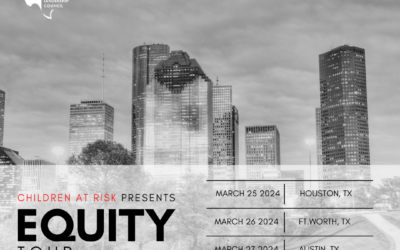
Teachers and administrators have spent the past 18 months re-envisioning the possibilities of the traditional classroom and what the future of education may hold for students today.
On August 4th, CHILDREN AT RISK hosted “Racial Equity in STEM Education,” a webinar exploring STEM education and career pathways with a racial equity lens. Presented by Shell Oil company and co-sponsored by AIG Life & Retirement and HP, educators and STEM experts gathered for an interactive discussion exploring racial inequities in STEM education.
To welcome attendees to this continued learning opportunity, Dr. Shannon Solis shared points on how to support young learning amidst the many crises that students face today and how educators can arm themselves to better meet the holistic needs of their students during this challenging time. She conveyed that sometimes a simple gesture such as a smile or a phone call can impact a student who may be struggling.
As Yohn Ellis, HP, noted later in the event, “a teacher’s words of encouragement can be the thing that creates the next Bill Hewlett or Dave Packard, or it can be the thing that deflates a student’s ambitions.”
Business leaders then took a moment to weigh in on increasing the intersectionality of STEM education and diversifying the STEM workforce by instilling leadership values in young adults.
“We have to attract, develop, and retain diverse talent, and this doesn’t start in high school or college.” Said Freda Lee, Senior Vice President and Head of Relationship Management with AIG Retirement Services. “We need to invest in and spend time with our middle-school students to help them understand which opportunities are available to them.”
Lee also highlighted how students often aren’t aware of the many opportunities available to them. She encouraged attendees to support student career exploration and cross-sector partnerships between large organizations, schools, and universities.
To support increasingly diverse student bodies and encourage diverse students to pursue STEM careers, HP experts discussed how we could begin to reinvent the classroom and the STEM student.
“We often look at the traditional STEM student, and we often think that they’ll look or act a certain way…But STEM is so much more than that,” said Les Mounteer of HP.
In the 21st century, YouTube and Tik Tok influencers engage in STEM as they work with social media algorithms, which can be said for most professional fields. As the opportunities in STEM are boundless, HP encouraged attendees to help their students find unique ways to integrate their hobbies and passions into their career trajectory and consider how STEM is already applicable to any field.
CHILDREN AT RISK Texas Racial Equity Collaborative Director, Sharon Watkins Jones
moderated a panel of STEM leaders and just a few of the “Hidden Figures” paving the way for students of color and making BIG differences in STEM fields.
Les Mounteer, Yohn Ellis, David Prasse, Nicole Halbert, and Dr. Alana Dvorak shared their personal journeys and spoke on the challenges they faced to finding success in STEM careers.
Dr. Anjanette Wyatt, CEO of Clinical Care Pharmacy, emphasized the need to supply students with mentors, particularly within the STEM field.
“That’s the key – to make room for the next generation to carry the baton and remembering those that have passed the baton to us [as mentors],” said Wyatt.
Dr. Stanley Lewis, CEO of Eselle Health, added that mentorship has been critical for his career trajectory and Gladus Henderson, Technical Project Manager with NASA Johnson Space Center, added that developing professional relationships and networking has made a difference for her career.
In her keynote presentation, Albert Einstein Distinguished Educator Fellow, Dr. Jennifer Stimpson, highlighted the need for cultural identity and representation to engage more students in STEM futures. Access to hands-on learning experiences and student leadership development are other great ways to encourage students, especially African American adolescent girls, to self-identifying as scientists and confidently pursuing careers in STEM.
“To have an interest in science, you must have an identity,” said Stimpson. “If we are intentional about changing the trajectory of who’s at the table… then we need to make every lesson a STEM career lesson, and we need to connect science to every opportunity that we can get. It’s not just the S the T the E and the M, its actuaries, and the accountants, and more. We need to make sure we redefine what each of those letters are.”
Watch a recording of the entire webinar below.
MORE LIKE THIS
2024 C@R Special Events
Special Eventsconvening for change Every dollar donated helps us improve the lives of Texas children. CHILDREN AT RISK is a 501(c)(3) non-profit organization (EIN: 76-0360533). Contributions are tax-deductible to the fullest extent allowed by law. ...
2023 Annual Report
It is with immense pride and joy that we announce the start of a significant milestone: the 35th Anniversary of CHILDREN AT RISK. For over three decades, our organization has been at the forefront of advocating for the well-being and rights of...
2024 Equity Tour
The Texas Equity Tour, slated for March and April 2024, is a pivotal event organized by CHILDREN AT RISK (C@R) to address systemic racism and its impact on Texas children and families. Rooted in the principles of racial equity, the tour serves as a...
2022-2023 CHILDREN AT RISK’s Annual School Rankings
For the past nineteen years, CHILDREN AT RISK (C@R) has ranked and graded Texas public schools to help parents, educators, and community members better understand how their local schools are performing. By providing this information to parents and...
2024 C@R Learning Events
Learning Eventsconvening for change CHILDREN AT RISK is committed to hosting free events that engage the public and help them drive change for children. We aim to share research, unpack pressing policy issues, and highlight diverse community...


